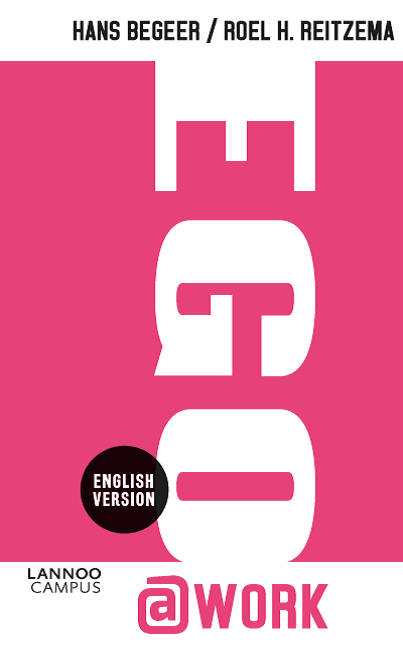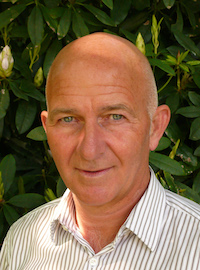By Hans Begeer for Enlivening Edge Magazine
 Ego is often seen as the enemy, certainly for those in power. In our new book Ego@work (Lannoo Campus 2020) we explore how I – the individual or ego can better align with We – the organization.
Ego is often seen as the enemy, certainly for those in power. In our new book Ego@work (Lannoo Campus 2020) we explore how I – the individual or ego can better align with We – the organization.
We, the authors, provide ways to make ego your ally, whether you are in power or not. We present a developmental model where an individual can grow his or her ego awareness, starting with being unconscious about the way ego prescribes behavior. This is the stage which we call the “loud ego.” We grow ego development towards what we call the “quiet ego.”
Different Aspects of the Ego
Through interaction with others a need arises to become more aware of different aspects of our ego.
We distinguish:
- ego-size: need to control, dominate and influence other people
- ego-permeability: how easily do I accept other influences and views?
- ego-fragility: openness to emotions
Through meeting others, colleagues and leaders, we can grow our consciousness about our ego and its different aspects and how it influences our behavior.
Some Examples
A boss with a big ego-size, with low ego-permeability and low ego-fragility will have a problem to let go control. He is in power and his ego is blocking to really delegate to others, probably as a reaction to anxiety or fear of the unknown. He probably is not aware of this influence as he is less interested in other people’s opinion—being low in ego-permeability. Also, he is not empathetic (low ego-fragility) so not aware of what it does with other people.
Another example is an employee with a small ego-size, high ego-permeability and high ego-fragility who has to deal with problems. How will he feel powerful enough to speak up about what he thinks and feels? His ego tells him that he will never be listened to and nobody perceives him doing anything.
From I, the Ego, to We, the Organization
We can meet with these two extreme positions in many variations. Therefore it is important to consider the context–the organization—as well. An organization consist of ego’s, as many as there are employees.
Just as the individual can grow awareness, we can also grow awareness in the organization. Is the organization structured top-down, with strong leaders? Are employees not very motivated to take ownership and responsibility?
In this type of environment, feedback and cooperation will be less developed. People remain rather isolated and will not be very open to consider reflection on how they behave—let alone going deeper into becoming more aware of their ego.
Leadership by Ego-management
We need something to happen in or outside the company for employees to feel a need for change—for instance, because customers stop buying or the competition becomes too strong. Or employees get bored or burn out. A change of leadership can make the difference. Two changes are: empowering the people and a leader showing examples of ego-management.
The leader shows the importance of real feedback on peoples’ behavior, including himself or herself. This can result in a new culture with new norms in which individual ego’s grow their consciousness together with the organization.
Stages of I and We Development within Organizations
I and We development go hand in hand; they need each other. The next table offers an overview of the different stages of I and We development.
| I | WE | |
|
1 |
LOUD EGO
• We respond to childish impulses |
FORMING
• We operate individually and in isolation with limited cohesion and cooperation |
|
2 |
EGO-AWARENESS
• We begin to recognize our ego and its facets • We request feedback |
STORMING
• Individuals begin to interact, react and collide; the concept of We begins to take root; we start giving feedback to colleagues |
|
3 |
EGO-MANAGEMENT
• We learn through iterative interactions how to adapt our behavior |
NORMING
• New norms, interconnectedness and interdependence emerge |
|
4 |
EMERGENCE OF THE QUIET EGO
• Inclusive • Empathic • Emotionally engaged |
PERFORMING
• New social contract • Authentic behaviors |
| 5 | SPIRIT WHOLENESS | |
Self-organization and Co-creation
We describe approaches to use our ego, so it helps us regaining power for ourselves and the organization. This is a condition for real self-organization and co-creation as I describe in another book (Co-creation is, Thirteen Myths Debunked, Lannoo Campus, 2016). It also opens the way to more Spirit and Wholeness.
Note from EE Magazine: Amazon.com carries only the Dutch version. The English version of the book is at the Lannoo website: https://www.lannoo.be/en/
 Hans Begeer is management consultant, facilitator and coach. He is an international advisor to multinational organizations in a wide range of business sectors via his practice BMC Consultancy. He publishes books and blogs about his experiences. www.bmc-consultancy.be
Hans Begeer is management consultant, facilitator and coach. He is an international advisor to multinational organizations in a wide range of business sectors via his practice BMC Consultancy. He publishes books and blogs about his experiences. www.bmc-consultancy.be
Featured




